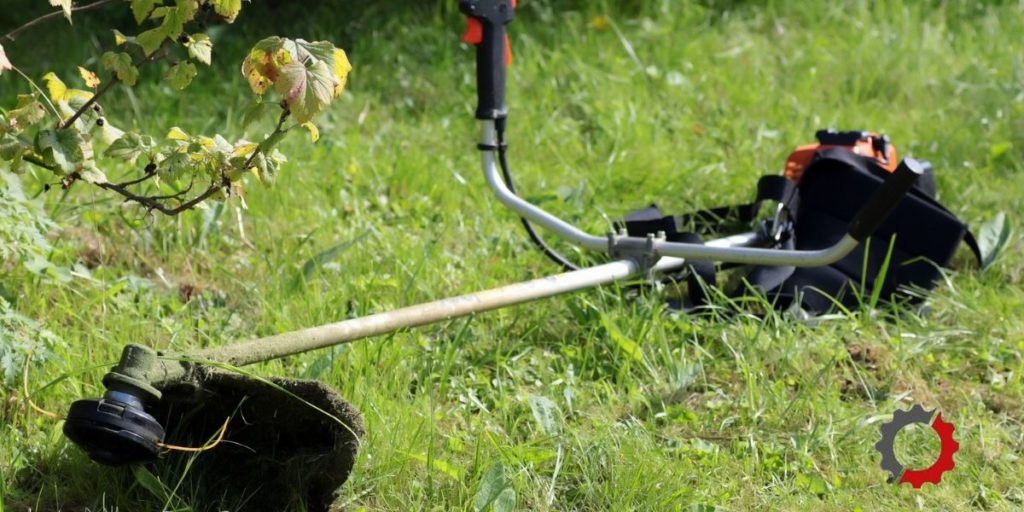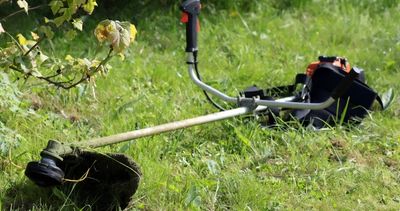A strimmer is a necessary tool to trim around garden landscaping and water features or cut grass that is too tall for a lawn mower to tackle. Just like any other piece of equipment, your strimmer is subject to wear and other failures over time.
A strimmer won’t start when it isn’t getting the air, fuel, or spark it requires for the engine to run. This can happen when the air filter or fuel filter is clogged; the fuel is old; the carburetor is dirty; the spark plug is bad, or the spark arrestor is plugged.
Keep reading for additional reasons a strimmer won’t start. Remember to perform routine maintenance on your strimmer to keep it running at its best. This will help reduce problems occurring when you need it most.

This post may include affiliate links. Purchases made through these links may provide a commission for us, at no extra cost to you. As an Amazon Associate, we earn from qualifying purchases.
Follow all safety instructions provided in your equipment operator’s manual prior to diagnosing, repairing, or operating.Consult a professional if you don’t have the skills, or knowledge or are not in the condition to perform the repair safely.
This is Why Your Strimmer Will Not Start
When troubleshooting the reason your strimmer won’t start, the first thing I do is replace the routine maintenance parts so I know one of these items isn’t negatively affecting the strimmer. This includes the fuel filter, air filter, and spark plug.
By changing these things, I immediately rule out the simple items as the cause of your starting problem.
Plugged Air Filter Will Cause a Strimmer Not to Start
The small engine on your strimmer requires air to run. Not only air but clean air so the engine doesn’t get damaged. Because of the dusty conditions created when operating a strimmer, an air filter is used to prevent dirt and debris from getting to the engine.
When the air filter becomes plugged, the air isn’t able to pass through the filter preventing your engine from getting clean air. This will prevent a strimmer from starting. Remove a dirty air filter and replace it with a new one.
Never run your strimmer without an air filter even it’s for a short period to finish a job. You put the engine at risk of permanent damage when you do so.
Fix: Remove the air filter and wipe out any remaining dirt from the air filter housing. Replace a dirty air filter with a new air filter.
Bad Spark Plug Will Cause a Strimmer Not to Start
A fouled spark plug covered in carbon, dirt, and oil can cause intermittent spark issues that can prevent the strimmer from starting.
Fix: Remove the spark plug and inspect it for buildup or damage. You can clean a dirty spark plug with a wire brush and reuse it. However, if it is extremely dirty, has a burnt electrode, or broken porcelain, it is best to replace it. This small part is important to starting and running a strimmer.
Plugged Fuel Filter Will Cause a Strimmer Not to Start
You will find the fuel filter inside the fuel tank. The filter is attached to the end of the fuel line to keep dirt and debris from entering the fuel system when the fuel becomes contaminated.
When the fuel you run through the strimmer is dirty, the fuel filter can become plugged restricting the amount of fuel leaving the fuel tank.
Fix: Locate the fuel filter in the fuel tank. Remove the old filter from the fuel line and replace it with a new fuel filter. You may have to use a clean bent wire to “fish” the filter out of the fuel tank.
Incorrect Petrol to Oil Mix in a 2-Cycle Strimmer
Using straight petrol in a 2-cycle strimmer will damage the engine and cause it to seize up. Adding straight petrol to your strimmer is a quick way to ruin it. The 2-cycle engine in a strimmer uses petrol and oil mixed at a ratio of 50:1, 40:1, or 32:1. For example, 50:1 mix equals 50 parts petrol to 1 part oil.
The ratio varies by manufacturer and age of the strimmer. You can find the correct mix ratio for your model in your operator’s manual. You may also find it on your original fuel cap.
When creating this mix, use petrol with a minimum of 95 RON and maximum ethanol content of 10%. Add a 2-cycle premium oil that is ISO-L-EGD and JASO M345 FD certified. Mix it in approved petrol can before adding it to your strimmer.
Fix: Drain the fuel tank and fill it with the correct petrol-to-oil mix. If you continue to have problems, have a small engine mechanic diagnose the problem and determine whether a cost-effective repair can be made.
2-Cycle Petrol to Oil Mix for a Strimmer
| Petrol to Oil Ratio | 5 Litre | 10 Litre | 1 Gallon | 2 Gallon |
|---|---|---|---|---|
| 50:1 | 100 ml | 200 ml | 2.6 oz | 5.2 oz |
| 40:1 | 125 ml | 250 ml | 3.2 oz | 6.4 oz |
| 32.1 | 156.25 ml | 312.50 ml | 4.0 oz | 8.0 oz |
Incorrect or Insufficient Engine Oil in a 4-Stage Strimmer
4-stage engines have separate fill ports, one for the engine oil and one for the fuel. DO NOT mix the oil and fuel together if you own this type of engine. Never use 2-cycle oil in a 4-stage strimmer.
Oil is required to keep the engine components lubricated. When the wrong type or not enough oil is used, friction can build in the engine and overheat causing your strimmer not to start and possibly ruin the engine.
Fix: Drain the engine oil and fill it with the correct oil grade. When running your strimmer in very cold or very hot temperatures, you may have to adjust the viscosity to your ambient temperature.
If you continue to have problems, have a small engine mechanic diagnose the problem and determine whether a cost-effective repair can be made.
Old Fuel Will Cause a Strimmer Not to Start
Old fuel left in a strimmer won’t only cause fuel restrictions, but it can also damage the carburetor and engine. Petrol can begin to break down as quickly as 30 days after purchase.
The ethanol found in petrol attracts moisture from the air. This moisture and ethanol mixture gums up the fuel system and components.
Because petrol can begin to break down and become less effective as soon as 30 days after purchase, the fuel must be consumed within this time frame. If you are unable to use it in this amount of time, add a fuel additive to stabilize the fuel so it lasts a little longer.
Always use petrol with a minimum of 95 RON and maximum ethanol content of 10% (E10). Never use E15 or E85 in the engine as this will damage the engine and most likely void manufacturer warranties.
Fix: Drain any old fuel remaining in your strimmer and fill it with fresh fuel. This is a petrol and oil mix for a 2-cycle engine and straight petrol for a 4-stage engine.
Add a fuel stabilizer like STA-BIL to stabilize the fuel, clean the fuel system and reduce moisture in the fuel.
Bad Primer Bulb Will Cause a Strimmer Not to Start
A cracked primer bulb that won’t fill up with fuel won’t function correctly to get fuel to the carburetor for starting the strimmer.
Fix: Replace with a new primer bulb.
Clogged Fuel Line Will Cause a Strimmer Not to Start
The strimmer’s fuel line can become clogged with deposits left behind by dirt and old fuel. When this happens, fuel to the engine is restricted which can cause the strimmer to not start.
Fix: Replace a fuel line in the strimmer when it is cracked, kinked or clogged.
Plugged Fuel Tank Vent Will Cause a Strimmer Not to Start
The fuel tank vent allows air into the tank. Without it, the fuel tank will form a vacuum and not allow petrol to flow out of the fuel tank. A good indication you may have a fuel tank vent problem is when your strimmer runs for a few minutes and then shuts down.
It won’t start until you remove the fuel cap to allow air into the fuel tank. It then shuts down again after running for several minutes with the fuel cap in place.
Fix: Replace the fuel tank vent so the air can flow into the fuel tank. Depending on the blower manufacturer, you will find the vent attached to a fuel line coming out of the fuel tank or in the fuel cap.
Clogged & Dirty Carburetor Will Cause a Strimmer Not to Start
The carburetor regulates the amount of fuel that is mixed with air to create a combustion in the cylinder. Old fuel will gum up and clog the carburetor so it no longer functions properly causing your strimmer not to start.
Fix: If you are a little mechanical you should be able to handle cleaning your carburetor. Clean the carburetor by taking it apart and using carburetor cleaner to clean it. If the carburetor does not function after being cleaned, you may need to rebuild it or replace it with a new carburetor.
Depending on the model strimmer you own and the price of the carburetor, it may be best to invest in a new strimmer rather than put money towards replacing a carburetor on an old strimmer.
Bad Recoil Starter Will Cause a Strimmer Not to Start
Your strimmer uses a recoil with a starter rope to start the engine. A bad pulley; loose or missing spring; or broken clips can keep your recoil from working.
Fix: You can attempt to replace the spring and restring the recoil. If it does not work because other components in your recoil are damaged, such as the clips or the pulley, you are better off just replacing the recoil assembly.
Bad Spark Arrestor Will Cause a Strimmer Not to Start
You will find a spark arrestor in your strimmer that can prevent it from starting. The spark arrestor is a small screen that can get plugged with soot.
Fix: Disconnect the spark plug boot. Remove the engine cover and engine exhaust cover. Remove the spark arrestor and clean it with a wire brush to remove the soot. If you are unable to clean it sufficiently or it is broken or has a hole in it, replace it with a new spark arrestor.
Reinstall the screen and reattach the exhaust and engine covers. Reconnect the spark plug boot when maintenance and repairs are complete.
Flooded Strimmer Will Cause It Not to Start
I have had customers bring their strimmer to the repair shop because they can’t get it started. Many times it’s due to a flooded engine which isn’t too serious.
The engine can become flooded when the choke is in the closed position and the starter rope was pulled many times allowing too much petrol to the carburetor.
It can also happen with the switch off and the starter rope is pulled multiple times or when the primer bulb is pushed too many times.
Fix: Use the following procedure to “unflood” your strimmer so the engine gets the correct fuel-to-air ratio required to start and run.
How to Fix a Flooded Engine on a Strimmer
- Turn the switch on to the run position.
- Move the choke lever to the run position.
- Press the throttle trigger while pulling the starter rope over and over. This can take anywhere between 5 and 15 pulls before it starts. Your strimmer engine will sputter first. Continue to pull a few more times and it should start.
